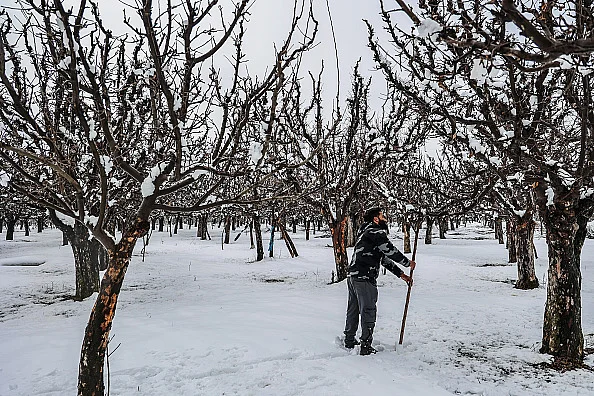For the past few years, unseasonal rainfall, high winds, and an early onset of summers in North India have meant that traditional farming patterns have been disrupted. The harvest of the regional staples wheat and mangoes has been affected in Western Uttar Pradesh and the quality of produce has fallen. In Himachal Pradesh, apple production has been hit by changing weather patterns and cultivation has shifted to higher reaches in the Himalayas.
While extreme weather conditions once in a few years are not uncommon and may cause occasional —even if considerable— loss of crops, such disturbances have become more of a norm in recent years. Such a situation has emerged over the past three decades as a consequence of climate change. A farmer from Meerut in West UP recalls they used quilts in April in the fields as recently as the late 1990s. Now, says this farmer, they stop wearing sweaters in March itself.
“Traditionally, the summers began with April, but now we see that February is more or less the end of winters and summers are practically there by the end of March. That way, the summers are setting in almost one month early. Such a situation has developed in the past two decades and we are seeing crops getting affected by this change,” says this farmer, who does not wish to be identified as he also holds a contractual job.
The early onset of summers and resultant higher temperatures result in wheat grains getting squeezed. This affects the overall yield from a field. Manmohan Sharma, a farmer from Bulandshahr in West UP, says the wheat grains that get squeezed from heat are much lighter in weight and inferior in quality.
“As the grains are lighter, the overall production is affected, which means that farmers don’t get the expected returns in terms of quantity. The lighter grains are also inferior in quality that no one prefers to buy and get sold at lower prices after grains of better quality have been sold,” says Sharma.
Since at least 2020, unseasonal rainfall in North India has become almost an annual phenomenon and has coincided with early summers — a double-whammy for farmers. Last year, the unseasonal heavy rainfall in March that followed high temperatures the month before flattened large swathes of wheat crops in North India and also damaged the mango production. Once the rains or hail have flattened wheat in swampy fields, decay may set in that may deal another blow to the farmers.
While the issues with wheat, mangoes, or apples are well understood, the issue with sugarcane —a mainstay crop of West UP— is not understood even by experts as entire fields have been damaged, says Digambar Singh, a farmer leader from UP’s Bijnor.
“The sugarcane crop in the fields is getting dried up. In some cases, entire fields have dried up in this manner. Agricultural scientists have also visited the fields, but there is no understanding yet about the exact cause. However, we know that it is a consequence of climate change. It’s a disease that has come with climate change,” says Singh, Youth State President of Bharatiya Kisan Union-Apolitical (BKU-A).
Climate Change Battering Crops From Plains To Hills
While wheat, sugarcane, mangoes, and rice take the brunt of climate change in West UP and the larger plains of North India, fruits are taking a big hit in the Himalayas.
While the typical snowfall period is December-February in Himachal Pradesh, there was no snowfall this year in December and January and the first spell only happened in February. This is damning for the state’s famed apples which need plenty of chilling period to grow. As two months of snowfall is lost, the produce is expected to be poor this year.
As snowfall reduces in the areas where apples have been conventionally grown for decades, and temperature also rises in these areas as a result of global warming, the cultivation has shifted to higher reaches in the Himalayas. Such a crisis is not just limited to apples in Himachal but is also extended to stone fruits like cherries, plums, and apricots, according to environmental scientist Satish Kumar Bhardwaj.
“Stone fruits like plums, apricots, and cherries also have chilling requirements. Now, we see snowfall delayed by up to two to three months. The warm conditions from the lack of snowfall affect their production. In the plainer regions of Himachal, we see drought-like conditions affecting the production of mangoes and guava. The traditional varieties grown in the region are the worst hit as the weather that they are used to is no longer there,” says Bhardwaj, Professor and Head, Department of Environment Sciences, YS Parmar University of Horticulture & Forestry, Solan.
Last year, in West UP, up to three-quarters of mango crops were damaged in some fields from high winds and heavy unseasonal rainfall, says a farmer with orchards in Bulandshahr.
The surviving crop, too, was not up to the mark.
“High winds lead to mangoes falling off the trees prematurely. The winds also damage buds that would grow into flowers. This affects farmers in two ways. One, smaller mangoes that fall prematurely are not sold easily. Two, the overall yield falls as smaller mangoes don’t fetch weight and production per field falls. This affects farmers’ incomes,” says this Bulandshahr-based third-generation farmer.
Other crops like mustard, cucumbers, and pumpkins also take a hit from weather disruptions in North India.
While the heatwaves have intensified in the northern plains, such extreme temperatures have also appeared in the past two to three decades in southern and eastern parts of the country where heatwaves were never known to occur, says Prof. Rajesh Kumar Mall, Dean and Head, Institute of Environment and Sustainable Development, Banaras Hindu University (BHU).
Mall tells Outlook, “In the last 25-30 years, we have observed the occurrence of heatwaves in Telangana, Andhra Pradesh, and Odisha. These areas were never known to have heatwaves. The studies show that the emergence of such new heatwave hotspots is going to increase in the coming decades.”
Mall further says that the adverse effect of heatwaves can be offset in the short term by increasing the irrigation of crops, but this is not a long-term solution.
“To offset the effect of heat on rice, the crop can be irrigated with much more water, as is the practice in West UP or Punjab where there is sufficient water for now, but water tables in these regions have already started to fall and this is not a sustainable approach. You cannot deplete water tables to sustain crops in this manner. The development of heat- and drought-resistant varieties for susceptible crops like wheat and rice is the only sustainable solution,” says Mall, who is also the Principal Investigator at BHU’s DST-Mahamana Centre of Excellence in Climate Change Research (MCECCR).
Grim Climate Change Projections For Farming
In the absence of appropriate climate adaptation, India could lose up to nearly half of its staple crops of wheat and rice in some cases, according to the Government of India’s projections.
In response to a parliamentary question, the then-Union Minister of Agriculture and Farmers Welfare Narendra Singh Tomar told Lok Sabha in March 2023 that, in the absence of adaptation measures, rainfed rice yields in India are projected to reduce by 20 per cent in 2050 and 47 per cent in 2080 while irrigated rice yields are projected to reduce by 3.5 per cent in 2050 and 5 per cent in 2080.
Climate change reduces crop yields and lowers the nutritional quality of produce, with extreme events like droughts affecting food and nutrient consumption, leaving adverse effects on farmers, said Tomar.
As for wheat, yield is projected to fall by 19.3 per cent in 2050 and 40 per cent in 2080 towards the end of the century with significant spatial and temporal variations, according to the reply.
Climate change is projected to reduce maize yields by 18 per cent and 23 per cent by 2050 and 2080 respectively, said Singh in the written response in Lok Sabha.
While these are grim projections, there is hope as India has been working towards climate adaptation practices for the past 10-15 years at a good pace and there is positive progress on the charts, says Prof. Rajesh Kumar Mall, Dean and Head of BHU’s Institute of Environment and Sustainable Development.
Mall tells Outlook, “We have developed newer varieties and are working on more of them. Even generally, we have had many interventions, such as the adoption of cleaner fuels, efficient vehicles, and the promotion of electronic vehicles (EVs). In a country as large as ours, it takes a lot of time for a change to set in, but we are headed in a positive direction if we sustain our pace and improve it.”
Newer Crop Varieties, Awareness Key To Managing Climate Change
In the wake of rising temperatures, unseasonal rainfall, and erratic snowfall that have disrupted generations of established weather and cropping patterns, the development of climate-resilient crop varieties along with an appropriate level of support from the government are the only viable solutions.
Environmental scientist Satish Kumar Bhardwaj tells Outlook that varieties of apples and stone fruits like apricots and plums have been developed and are further being worked upon that don’t require too much snow or cold conditions.
“The disruption of snowfall patterns is not just limited to Himachal Pradesh, but it is seen throughout the Himalayan region including Uttarakhand and Jammu and Kashmir as well. Besides less and irregular snowfall, we are now also seeing fires in the hills at heights not seen earlier. This is because these regions are now witnessing dry and warm conditions for fires which they never did earlier,” says Bhardwaj, Head of the Department of Environmental Studies at YS Parmar University of Horticulture & Forestry, Solan.
Crop diversification is another solution, which involves changing the crops that are grown. In Himachal, that would mean increasing the cultivation of ‘perennial crops’ instead of seasonal and weather-dependent crops. In West UP and Punjab, that would mean reducing the cultivation water-guzzling crops like rice and increasing the growing of less water-intensive crops like millets, which the Narendra Modi government is also actively promoting. But none of this will happen if the farmers are not aware.
Digambar Singh, a farmer leader from UP’s Bijnor, says that farmers lack awareness about best practices and resort to indiscriminate use of pesticides as a result.
“Farmers are dependent on pesticide shop owners for advice and they are untrained people. Their only advice is to spray more pesticides. While pesticides save the crop, the chemicals damage the soil in the long run and even affect the crop’s health even if they keep the pests away. The government should empower agricultural research institutions and carry out awareness programmes so the farmers know how to manage climate change and crop diseases,” says Singh.
As for the government schemes, Singh says that crop insurance is essential and should be widely adopted but has many roadblocks.
“The insurance companies delay the processing of farmers’ claims. Moreover, in some cases, there is a criterion that a gram panchayat is taken as a single unit and the compensation would be issued only when the entire village is affected. Claims should be settled against individual farms and villages should not be taken as a unit. Moreover, even when claims are finally processed, investigation is delayed. Sometimes, the insurance officials would not come. When they would come, the government officials would not come. In this age of the internet, you can have quick visits and can have verification via videos for quick settling of claims. It’s a good policy but it loses the purpose when claims are not settled or are delayed too much,” says Singh.


























